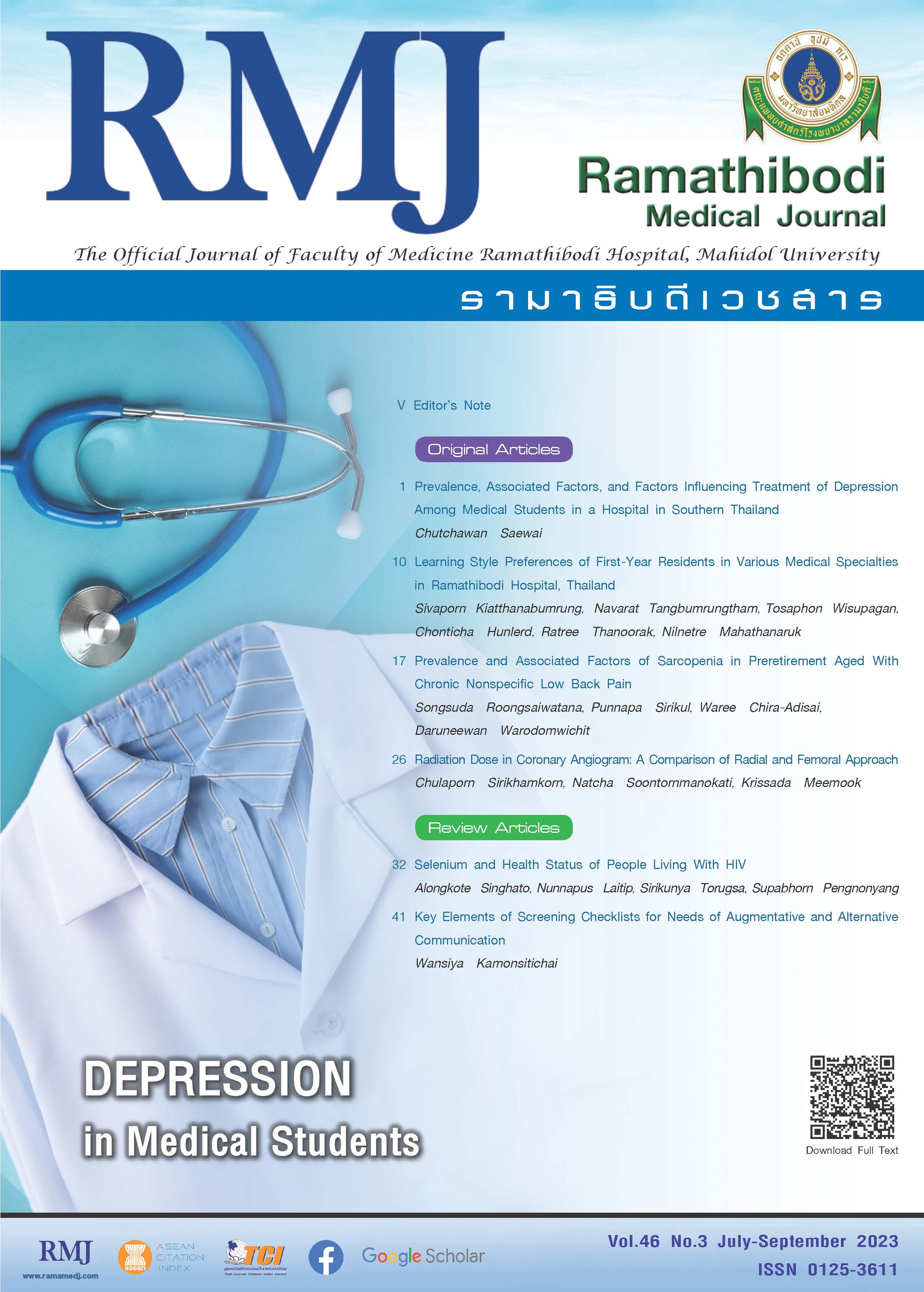Selenium and Health Status of People Living With HIV
DOI:
https://doi.org/10.33165/rmj.2023.46.3.262787Keywords:
HIV, AIDs, Nutrition, Selenium, FoodAbstract
Selenium is an essential trace element that plays a key role in the human immune system. People living with HIV (PLHIV) are a risk group of people who suffer from opportunistic infection due to their immune function impairment. Hence, encouraging adequate selenium intake among PLHIV is one of the key factors to promote their health status. This article aims to present the importance of selenium, sources of selenium, and the importance of selenium for the health status of PLHIV, as well as, the effects of selenium supplementation for PLHIV in various groups on their health. The results from previous studies and pieces of literature have been searched and found in a confidential and acceptable database. In conclusion, selenium is a crucial element required by the PLHIV. However, future studies are needed to investigate the appropriate amount of daily selenium supplementation for PLHIV in Thailand.
References
Barchielli G, Capperucci A, Tanini D. The role of selenium in pathologies: an updated review. Antioxidants (Basel). 2022;11(2):251. doi:10.3390/antiox11020251
World Health Organization. Vitamin and Mineral Requirement in Human Nutrition: Selenium. 2nd ed. World Health Organization; 2004:194-216. Accessed May 1, 2023. https://www.who.int/publications/i/item/9241546123
Navia B, Ortega RM, Perea JM, et al. Selenium status in a group of schoolchildren from the region of Madrid, Spain. J Hum Nutr Diet. 2014;27 Suppl 2:239-246. doi:10.1111/jhn.12126
Bunupuradah T, Pinyakorn S, Puthanakit T. Prevalence of selenium deficiency in Thai HIV-infected children without severe HIV symptoms. Eur J Clin Nutr. 2012;66(11):1278. doi:10.1038/ejcn.2012.116
Avery JC, Hoffmann PR. Selenium, selenoproteins, and immunity. Nutrients. 2018;10(9):1203. doi:10.3390/nu10091203
Vidya Vijayan KK, Karthigeyan KP, Tripathi SP, Hanna LE. Pathophysiology of CD4+ T-cell depletion in HIV-1 and HIV-2 infections. Front Immunol. 2017;8:580. doi:10.3389/fimmu.2017.00580
Tepungipame AT, Tonen-Wolyec S, Kalla GC, et al. Predictors of AIDS-related death among adult HIV-infected inpatients in Kisangani, the democratic republic of Congo. Pan Afr Med J. 2020;37:144. doi:10.11604/pamj.2020.37.144.25802
Bruchfeld J, Correia-Neves M, Källenius G. Tuberculosis and HIV coinfection. Cold Spring Harb Perspect Med. 2015;5(7):a017871. doi:10.1101/cshperspect.a017871
Pellowski JA, Price DM, Harrison AD, et al. A systematic review and meta-analysis of antiretroviral therapy (ART) adherence interventions for women living with HIV. AIDS Behav. 2019;23(8):1998-2013. doi:10.1007/s10461-018-2341-9
Gilbert HN, Wyatt MA, Pisarski EE, et al. How community ART delivery may improve HIV treatment outcomes: qualitative inquiry into mechanisms of effect in a randomized trial of community-based ART initiation, monitoring and re-supply (DO ART) in South Africa and Uganda. J Int AIDS Soc. 2021;24(10):e25821. doi:10.1016/s2214-109x(20)30385-5
National Institute of Health. Selenium: Fact Sheet for Health Professionals. Updated March 26, 2021. Accessed May 1, 2023. https://ods.od.nih.gov/factsheets/Selenium-HealthProfessional/
Bureau of Nutrition, Department of Health, Ministry of Public Health. Dietary Reference Intake for Thais 2020. A.V. Progressive Ltd; 2020. Accessed May 1, 2023. https://www.thaidietetics.org/wp-content/uploads/2020/04/dri2563.pdf
Rayman MP. Selenium and human health. Lancet. 2012;379(9822):1256-1268. doi:10.1016/S0140-6736(11)61452-9
Singhato A, Judprasong K, Sridonpai P, et al. Effect of different cooking methods on selenium content of fish commonly consumed in Thailand. Foods. 2022;11(12):1808. doi:10.3390/foods11121808
Bekker LG, Alleyne G, Baral S, et al. Advancing global health and strengthening the HIV response in the era of the Sustainable Development Goals: the International AIDS Society-Lancet Commission. Lancet. 2018;392(10144):312-358. doi:10.1016/S0140-6736(18)31070-5
Joint United Nations Programme on HIV/AIDS. UNAIDS data 2022. Accessed May 1, 2023. https://www.unaids.org/sites/default/files/media_asset/data-book-2022_en.pdf
Joint United Nations Programme on HIV/AIDS. In Danger: UNAIDS Global AIDS Update 2022. Accessed May 1, 2023. https://www.unaids.org/sites/default/files/media_asset/2022-global-aids-update-summary_en.pdf
Shivakoti R, Gupte N, Yang WT, et al. Pre-antiretroviral therapy serum selenium concentrations predict WHO stages 3, 4 or death but not virologic failure post-antiretroviral therapy. Nutrients. 2014;6(11):5061-5078. doi:10.3390/nu6115061
Kiełczykowska M, Kocot J, Paździor M, Musik I. Selenium - a fascinating antioxidant of protective properties. Adv Clin Exp Med. 2018;27(2):245-255. doi:10.17219/acem/67222
Bermano G, Méplan C, Mercer DK, Hesketh JE. Selenium and viral infection: are there lessons for COVID-19? Br J Nutr. 2021;125(6):618-627. doi:10.1017/S0007114520003128
Hadadi A, Ostovar A, Edalat Noor B, et al. The effect of selenium and zinc on CD4(+) count and opportunistic infections in HIV/AIDS patients: a randomized double blind trial. Acta Clin Belg. 2020;75(3):170-176. doi:10.1080/17843286.2019.1590023
Okunade KS, Olowoselu OF, John-Olabode S, et al. Effects of selenium supplementation on pregnancy outcomes and disease progression in HIV-infected pregnant women in Lagos: a randomized controlled trial. Int J Gynaecol Obstet. 2021;153(3):533-541. doi:10.1002/ijgo.13514
Guillin OM, Vindry C, Ohlmann T, Chavatte L. Interplay between selenium, selenoproteins and HIV-1 replication in human CD4 T-lymphocytes. Int J Mol Sci. 2022;23(3):1394. doi:10.3390/ijms23031394
Kamwesiga J, Mutabazi V, Kayumba J, et al. Effect of selenium supplementation on CD4+ T-cell recovery, viral suppression and morbidity of HIV-infected patients in Rwanda: a randomized controlled trial. AIDS. 2015;29(9):1045-1052. doi:10.1097/QAD.0000000000000673
Baum MK, Campa A, Lai S, et al. Effect of micronutrient supplementation on disease progression in asymptomatic, antiretroviral-naive, HIV-infected adults in Botswana: a randomized clinical trial. JAMA. 2013;310(20):2154-2163. doi:10.1001/jama.2013.280923
Okunade KS, John-Olabode S, Akinsola OJ, Akinajo O, Akanmu SA, Kanki PJ. Effects of selenium supplementation on pregnancy outcome and disease progression in HIV-infected pregnant women in Lagos, Nigeria: study protocol for a randomised, double-blind, placebo-controlled trial. Medicine (Baltimore). 2019;98(3):e12735. doi:10.1097/MD.0000000000012735
Sudfeld CR, Aboud S, Kupka R, Mugusi FM, Fawzi WW. Effect of selenium supplementation on HIV-1 RNA detection in breast milk of Tanzanian women. Nutrition. 2014;30(9):1081-1084. doi:10.1016/j.nut.2014.01.011
Watanabe LM, Barbosa Júnior F, Jordão AA, Navarro AM. Influence of HIV infection and the use of antiretroviral therapy on selenium and selenomethionine concentrations and antioxidant protection. Nutrition. 2016;32(11-12):1238-1242. doi:10.1016/j.nut.2016.03.024
Pourmoradian S, Rezazadeh L, Tutunchi H, Ostadrahimi A. Selenium and zinc supplementation in HIV-infected patients. Int J Vitam Nutr Res. 2023;10.1024/0300-9831/a000778. doi:10.1024/0300-9831/a000778
Monteiro JP, Kussmann M, Kaput J. The genomics of micronutrient requirements. Genes Nutr. 2015;10(4):466. doi:10.1007/s12263-015-0466-2
Downloads
Published
How to Cite
Issue
Section
License
Copyright (c) 2023 Ramathibodi Medical Journal

This work is licensed under a Creative Commons Attribution-NonCommercial-NoDerivatives 4.0 International License.

















